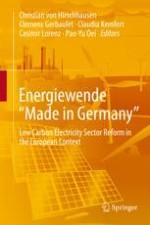2018 | OriginalPaper | Buchkapitel
10. The Electricity Mix in the European Low-Carbon Transformation: Coal, Nuclear, and Renewables
verfasst von : Roman Mendelevitch, Claudia Kemfert, Pao-Yu Oei, Christian von Hirschhausen
Erschienen in: Energiewende "Made in Germany"
Aktivieren Sie unsere intelligente Suche, um passende Fachinhalte oder Patente zu finden.
Wählen Sie Textabschnitte aus um mit Künstlicher Intelligenz passenden Patente zu finden. powered by
Markieren Sie Textabschnitte, um KI-gestützt weitere passende Inhalte zu finden. powered by
